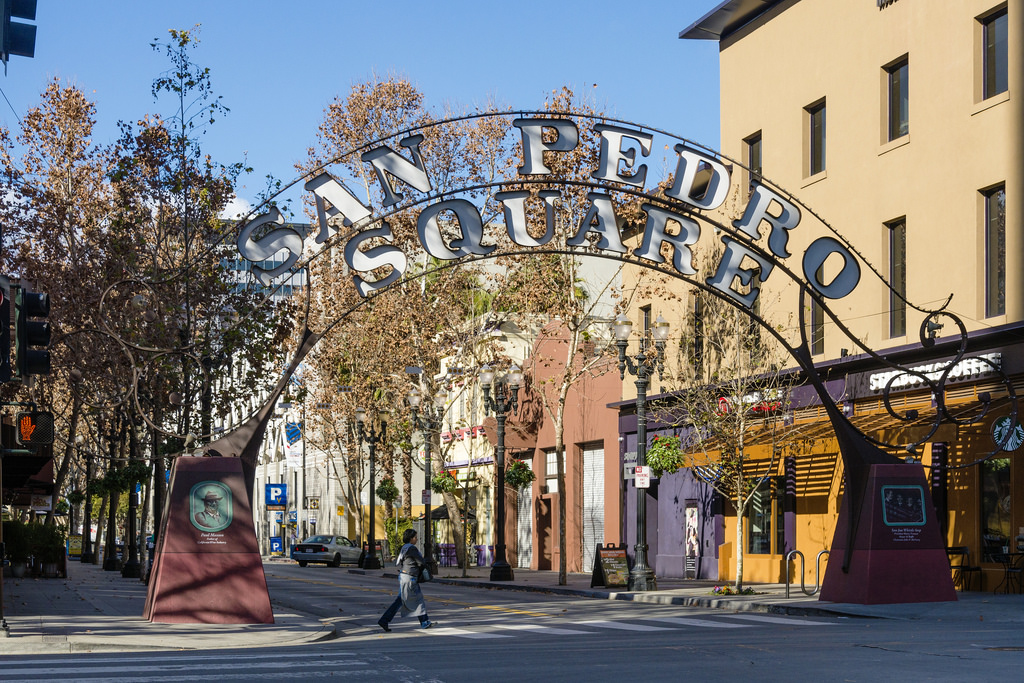
Charting a course for downtown San Jose, Calif.
Egon Terplan is regional planning director of SPUR, a century-old nonprofit founded in San Francisco that promotes good urban planning throughout the Bay Area. Knight supported SPUR’s expansion to San Jose, a Knight community, in 2012. Photo by: Sergio Ruiz, courtesy SPUR.
A great city begins in its downtown. It sets the tone. People come downtown to celebrate, grieve and protest. They come to work and play.
But what is the right strategy when the downtown of the 10th-largest city in the country, home to more than a million people, has less than 40,000 jobs, 10 percent of its own city’s job base? What if that downtown is located in a region with two other major urban centers – San Francisco and Oakland – each with a much larger and more established downtown and an ability to build high-rises?
This is the case of downtown San Jose.
It is neither small enough to navigate easily nor large enough to draw significant crowds on a regular basis. Its tallest towers top out at about 20 stories as downtown lies in the flight path of the nearby airport. But it’s also the urban anchor of Silicon Valley, with its wide scattering of jobs, homes and entertainment.
Downtown needs more people on a daily basis, not just for major festivals and events, but to help us make the most of our growing region.
For decades, downtown was the beneficiary of several billion dollars invested by California’s largest redevelopment agency – before the state dissolved them all in 2012. The redevelopment agency played every trick and more in the downtown revitalization toolkit – high-quality parks and public spaces, museums, theater, light rail on a transit mall, a convention center, corporate relocations (Adobe), an NHL hockey team and other amenities.
While these investments did not produce a full-scale revitalization, they did provide the infrastructure to accommodate a much larger downtown. With a growing appreciation of the need for an urban center, the timing may be right to reappraise that vision.
SPUR began examining what downtown San Jose needs by researching the historical planning moves that shaped today’s downtown. After an additional year of research, workshops and focused effort by a diverse number of downtown leaders, we identified six big ideas for a more successful and active downtown:
1. Use downtown as a demonstration zone for achieving the city’s goal to reduce driving. San Jose wants to cut solo driving in half by 2040, an ambitious goal for a low-density city mostly built after WWII. The city should start with downtown as a pilot, then expand the techniques that work to the rest of the city.
2. Reserve major unbuilt sites around future regional transit stations for jobs.
Proximity to one’s workplace correlates strongly with taking transit, so jobs – instead of housing – should go closest to transit investments such as planned subway and high-speed rail stations.
3. Eliminate minimum parking requirements in new development. The city has a lot of parking already, but it requires new developments to build more. San Jose can’t create a busy, active downtown when parking takes up 40 percent of some buildings.
4. Require new development to have tall ceiling heights and active uses on the ground floor. “Active uses,” such as storefronts, add vitality to urban life, and tall ceilings make businesses more pleasant, welcoming and successful. Meanwhile, “inactive uses,” such as parking structures and blank walls, make streets feel desolate and uninviting.
5. As a precursor to high-speed rail, create a faster Caltrain bullet service that connects San Jose and San Francisco in less than 60 minutes. Caltrain’s upcoming switch to electric engines will allow trains to go faster. We should use this opportunity to give commuters a taste of faster regional transit, and whet their appetite – and support – for the state’s plan for high-speed rail between major cities.
6. Make it easier to hold concerts, festivals and other events by reducing barriers such as permit costs. Downtown San Jose comes alive during events such as Summer Jazz Fest and Christmas in the Park. But strict regulations and high permit fees make it hard to replicate these successes on a regular basis. Downtown can become lively year round with a few minor policy changes.
It is always difficult to shift patterns of investment – and it’s particularly challenging in San Jose, given the historical patterns and current decentralized landscape of the South Bay. We think San Jose needs to focus on the fundamental tools that can have a big impact. Over the next decade, these ideas will help the current downtown evolve and thrive.
Read the full report, “The Future of Downtown San Jose: How the South Bay’s Urban Center Can Achieve Its Potential”
Recent Content
-
Community Impactarticle ·
-
Community Impactarticle ·
-
Community Impactarticle ·


